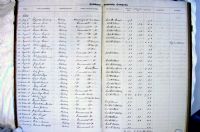|
|
Reading Mercury
Dated 30th August 1851
FATAL ACCIDENT IN A WELL. – On Thursday evening, an inquest was held at Pigeon’s, St Mary’s Hill, before Joseph Bunny, Esq., the borough coroner, on view of the body of George Smith, who was killed by the falling of bricks and earth in the sinking of a well belonging to Mr. Nutley, the previous day. After the return of the jury from viewing the body, the coroner remarked that it ought to be satisfactorily shown to the jury that sufficient care had been taken in digging the well. He then called John Withers, the contractor and informed him that he would be at liberty to ask the witnesses any question after they had been examined. – Thomas Parr stated that he was a bricklayer, and commenced working at the well on Monday afternoon. It was an old well about twenty feet deep, and they began on that day sinking it. They got down on Monday about one foot and a half. Tuesday the work progressed satisfactorily. On Wednesday afternoon, about two o’clock, deceased, witness, and two other fellow-workmen talked over as to who should go down the well next, when the deceased said, he would go down, at the same time saying “we shall go on well.” They worked up to six o’clock, and everything seemed to be going on well. Just after that time witness saw the bricks and earth suddenly fall on the deceased, when he called out “dear Tom.” Witness went down and worked as hard as he could for upwards of an hour in trying to extricate the deceased. Nearly the whole of that time they frequently spoke to each other, and the deceased last words were “Tom remove this off my head, or I shall die here.” Witness called again, but received no answer. Being much exhausted by working so hard, he came up. In answer to questions from the coroner and jurors, he stated that he thought there was about six feet of bricks and earth on the deceased; he removed about three feet off him; only one could work at the time in the well; did not see any danger before the accident, and believed that every precaution had been taken in the matter. – Geo. Marshall, bricklayer, stated that he worked for Mr. Balding; heard of the accident, and went to the place; Mr. Withers asked him to go down into the well; worked there in removing the bricks and ground for three quarters of an hour; when he got at the deceased, he was in a standing position, and his face was under water; he was quite dead; witness called for a rope to pull him up. Several questions were asked of Marshall by the Coroner and Jury, as to whether he thought that proper precaution had been taken to prevent an accident in the lowering of the well? Marshall stated that he had had a great deal to do with digging wells, and was of the opinion that there was more danger in lowering old dwells than digging new ones; in this case, he did not think there was any blame to be attached to any one, from what he saw of the work. – George Wherrell, another workman, was shortly examined, his evidence corroborated Parr’s examination. The coroner informed Mr. Withers, if he had anything to state to the Jury, he could now do it. Withers bore testimony to the evidence, and believed it to be very correctly given. – The coroner made a few observations on the evidence, and it appeared from the testimony of Marshall, who was not biased in any way, and who had given his evidence in a fair and straightforward manner, that no blame was attached to any one, and that from the fact that the deceased’s face, when discovered by Marshall, being under water, death might have been caused by suffocation. The Jury almost immediately returned their verdict, “Accidental death,”- The deceased and Wherrell had a sub-contract under John Withers, who had no control over them in doing the work, and therefore, no blame can be attached to Withers. – Mr. Carter, surgeon, was in attendance, and thought it advisable to try the effect of galvanism; Mr. J. Rand being readily provided with his powerful apparatus, he immediately commenced, but unfortunately the vital spark had forever fled. The experiment was considered decidedly satisfactory, and we wish it had been witnessed by other members of the medical profession, as it contracted the muscles, and produced a reaction in the chest and limbs, thus convincing the most sceptical, of the great utility of this powerful agent, in all cases of suspended animation.
|



